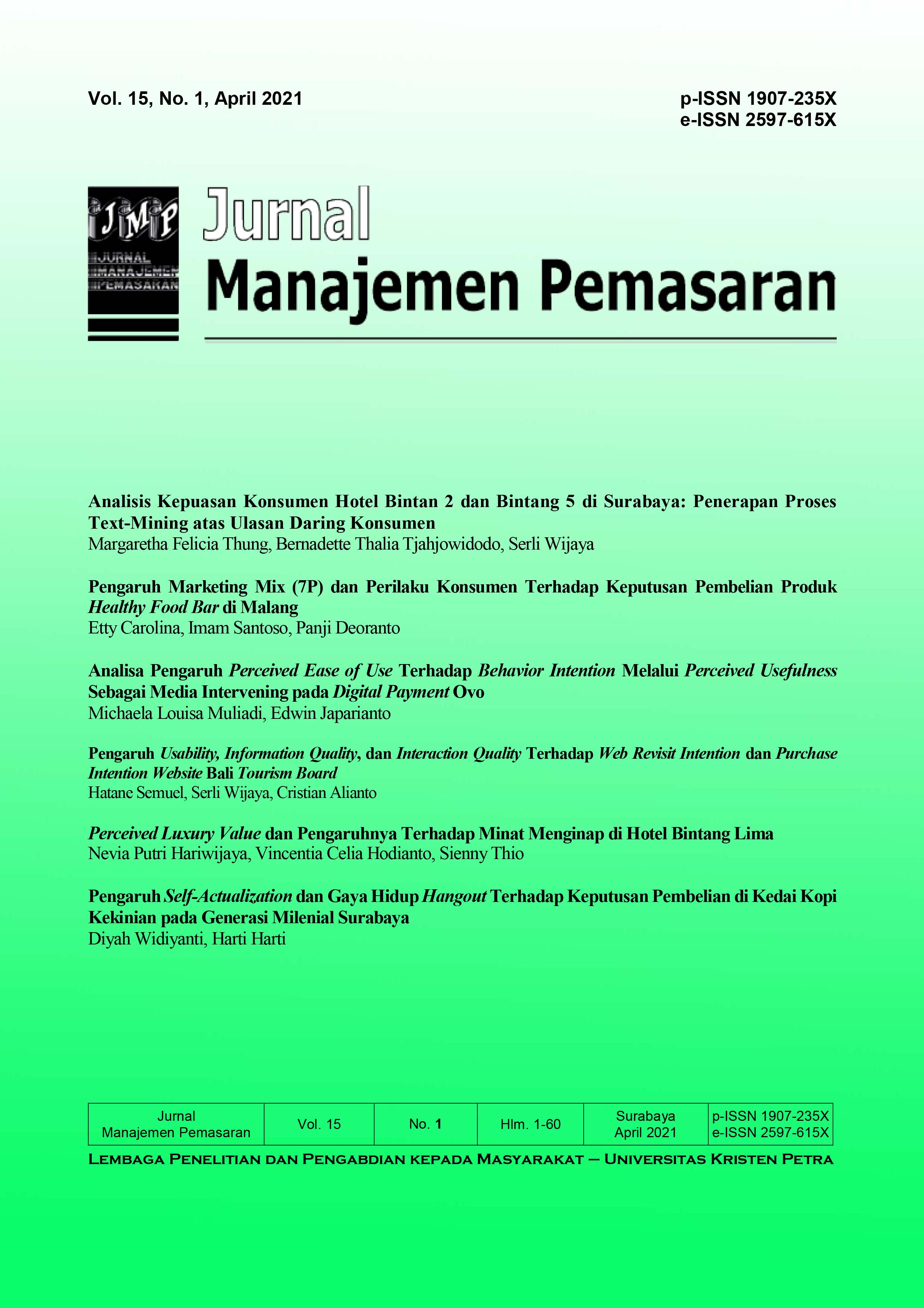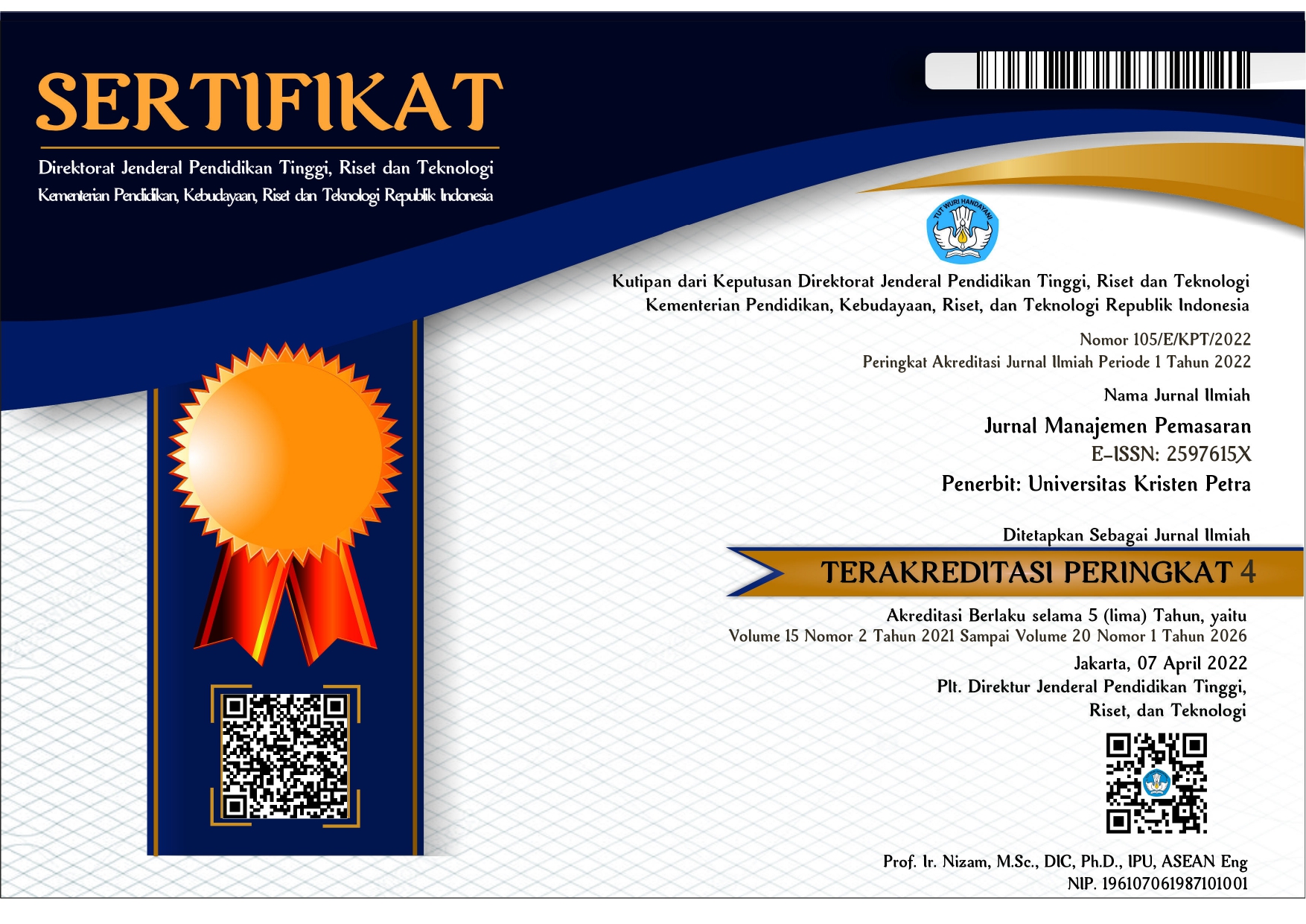SHOPPING ORIENTATION, STATUS CONSUMPTION AND IMPULSE BUYING OF GENERATION X AND Y IN PURCHASING FAST FASHION PRODUCTS
DOI:
https://doi.org/10.9744/pemasaran.15.2.110-118Keywords:
Generational cohort, shopping orientation, status consumption, impulse buyingAbstract
Generation cohorts have different tendencies in purchase behaviors, especially the Generation X and the Generation Y. Although the age gap between these two generation cohorts is not wide, the Generation X has distinctive purchase behaviors that are different from the Generation Y. In the fashion business, the Generation X consumers do not consider the brands in purchasing their clothes, but they calculate the benefits in buying a clothing product. However, the Generation Y consumers consider it as a part of their social status, therefore, they position themselves in the middle class or the upper class by what they wear. The aim of this research is to investigate the different purchase behaviors of the Generation X and Y in buying fast fashion products in Surabaya. The purchase behaviors are reflected through such variables as shopping orientation, status consumption, and impulse buying. As this is a quantitative research, the data are collected using questionnaires that are distributed to 100 respondents. The respondents are chosen using the purposive sampling technique. Then, the data are tested for the validity, reliability, normality, and homogeneity. To test the hypothesis, the independent samples t-test is used. The results show that the differences between the Generation X and the Generation Y are significant in their shopping orientation and impulse buying. However, there are no significant differences in the status consump-tions.
References
Azarian, R. (2011) Potentials and limitations of com-parative method in social science. International Journal of Humanities and Social Science, 1(4), 113–125.
Badan Pusat Statistik. (2018). Rata rata pengeluaran per kapita sebulan menurut kelompok barang (rupiah), 2013–2017. Retrieved from https://www. bps.go.id/statictable/2014/12/18/966/rata-rata-pengeluaran-per-kapita-sebulan-menurut-kelom¬pok-barang-rupiah-2013-2017.html.
Badgaiyan, A. J., Verma, A., & Dixit, S. (2016). Impul-sive buying tendency: Measuring important relationships with a new perspective and an indigenous scale. IIMB Management Review, 28, 186–199.
Bhardwaj, V., & Fairhurst, A. (2010) Fast fashion: Response to changes in the fashion industry. The International Review of Retail, Distribution and Consumer Research, 20(1) 165–173.
Bilgihan, A. (2016). Gen y customer loyalty in online shopping: An integrated model of trust, user experience and branding. Computers in Human Behavior, 61, 103–113.
Chairiyani, R. P. (2014) Semiotika batik larangan di Yogyakarta. Humaniora, 5(2), 1177–1186.
Chang, H. J., Eckman, M., & Yan, R. N. (2011) Application of the stimulus-organism-response model to the retail environment: The role of hedonic motivation in impulse buying behavior. The International Review of Retail, Distribution and Consumer Research, 21(3), 233–249.
Choudhary, S. (2014). Study of impulse buying beha-viour of consumers. International Journal of Advances Research in Computer Science and Management Studies, 2(9), 1–4.
Colucci, M., & Scarpi, D. (2013) Generation y: Evi-dences from the fast-fashion market and implications for targeting. Journal of Business Theory and Practice, 1(1), 1–7.
Cooper, D. R., & Schindler, P. S. (2014) Business research method. New York, NY: McGraw-Hill.
Crane, D. (2000) Fashion and its social agendas: Class, gender, and identity in clothing. Chicago, IL: The University of Chicago Press.
Eastman, J. K., & Liu, J. (2012) The impact of generational cohorts on status consumption: An exploratory look at generational cohort and demographics on status consumption. Journal of Consumer Marketing, 29(2), 93–102.
Flight, R. L., & Scherle, J. (2013) Shopping context and the impulsive and compul¬sive buyer. Atlantic Marketing Journal, 2(2), 54–68.
Gabrielli, V., Baghi, I., & Codeluppi, V. (2012) Consumption practices of fast fashion products: A consumer-based approach. Journal of Fashion Marketing and Management, 17(2), 206–224.
Gehrt, K. C., Rajan, M. N., Shainesh, G., Czerwinski, D., & O’Brien, M. (2012) Emergence of online shopping in India: Shopping orientation segments. International Journal of Retail & Distribution Management, 40(10), 742–758.
Gurău, C. (2012) A life-stage analysis of consumer loyalty profile: Comparing generation x and millennial consumers. Journal of Consumer Marketing, 29(2), 103–133.
Jensen, J. M. (2012) Shopping orientation and online travel shopping: the role of travel experience. International Journal of Tourism Research, 14(1), 56–70.
Johnson, K., Lennon, S. J., & Rudd, N. (2014) Dress, body and self: Research in the social psychology of dress. Fashion and Textiles, 1(20), 1–24.
Khan, N., Hui, L. H., Chen, T. B., & Hoe, H. Y. (2016). Impulse buying behaviour of generation y in fashion retail. International Journal of Business and Management, 11(1), 144–151.
Kicheva, T. (2017). Management of employees from different generations – Challenge for Bulgarian managers and HR professionals. Economic Alternatives, 1, 103–121.
Kotler, P., & Armstrong, G. (2016) Principles of marketing. Global Edition – 16th Edition. Essex: Pearson Education Limited.
Kwan. O. G. (2016) Pengaruh sales promotion dan store atmosphere terhadap impulse buying dengan positive emotion sebagai variable intervening pada Planet Sport Tunjungan Plaza Surabaya. Jurnal Manajemen Pemasaran, 10(1), 27–34.
Lemeshow, S., Hosmer Jr., D. W., Klar, J., & Lwanga, S. K. (1990). Adequacy of sample size in health studies. West Sussex, England: John Wiley & Sons Ltd.
Lissitsa, S., & Kol, O. (2016). Generation x vs. generation y - A decade of online shopping. Journal of Retailing and Consumer Services, 31, 304–312.
Mai, N. T. T., & Tambyah, S. K. (2011). Antecedents and consequences of status consumption among urban Vietnamese consumers. Organizations and Markets in Emerging Economies, 2(1), 75–98.
Noble, S. M., & Schewe, C. D. (2003) Cohort segmentation: An exploration of its validity. Journal of Business Research, 56, 979–987.
Ordun, G. (2015). Millenial (gen y) consumer behavior, their shopping preferences and perceptual maps associated with brand loyalty. Canadian Social Science, 11(4), 40–55.
Parry, E., & Urwin, P. (2011) Generational differences in work values: A review of theory and evidence. International Journal of Management Reviews, 13(1), 79–96.
Petra, K. K. (2016). Generation y attitudes towards shopping: A comparison of the Czech Republic and Slovakia. Journal of Competitiveness, 8(1), 38–54.
Pickvance, C. (2005) The four varieties of comparative analysis: The case of environmental regulation. In National centre for research methods and ESRC symposium on small and large-n comparative solutions, September 22–23 2005, University of Sussex, Brighton. Unpublished. Retrieved April 1, 2019, from http://eprints.ncrm.ac.uk/57/.
Reisenwitz, T., & Iyer, R. (2009) Differences in generation x and generation y: Implications for the organization and marketers. The Marketing Management Journal, 19(2), 91–103.
Seock, Y. K. (2003). Analysis of clothing websites for young consumer retention based on a model of customer relationship management via the internet. Unpublished dissertation, Virginia Polytechnic Institute and State University.
Seock, Y. K., & Bailey, L. R. (2008). The influence of college students’ shopping orientations and gender differences on online information searches and purchase behaviors. International Jour¬nal of Consumer Studies, 32(2), 113–121.
Sharma, P., Sivakumaran, B., & Marshall, R. (2011) Deliberate self-indulgence versus involuntary loss of self-control: Toward a robust cross-cultural consumer impulsiveness scale. Journal of International Consumer Marketing, 23(3–4), 229–245.
Ting, H., & de Run, E. C. (2012). Generations x and y attitude towards controversial advertising. Asian Journal of Business Research, 2(2), 24–39.
Ting, H., Lim, T. Y., de Run, E. C., Koh, H., & Sahdan, M. (2018) Are we baby boomers, gen x and gen y? A qualitative inquiry into generation cohorts in Malaysia. Kasetsart Journal of Social Sciences, 39(1), 109–115.
Valaei N., & Nikhashemi, S. R. (2017) Generation y consumers’ buying behaviour in fashion apparel industry: A moderation analysis. Journal of Fashion Marketing and Management: An inter-national journal, 21(4), 523–543.
Vinoth, S. & Balaji, S. G. (2015). Changing consumer behviour between generation x and generation y on e-tailing (online shopping) – An empirical study. International Journal of Business and Administration Research Review, 2(II), 212–217.
Yigit, S., & Aksay, K. (2015). A comparison between generation x and generation y in terms of individual innovativeness behavior: The case of Turkish health professionals. International Journal of Business Administration, 6(2), 106–117.

















